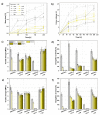Biocomposites of Epoxidized Natural Rubber/Poly(Lactic Acid) Modified with Natural Substances: Influence of Biomolecules on the Aging Properties (Part II)
- PMID: 34064033
- PMCID: PMC8196701
- DOI: 10.3390/polym13111677
Biocomposites of Epoxidized Natural Rubber/Poly(Lactic Acid) Modified with Natural Substances: Influence of Biomolecules on the Aging Properties (Part II)
Abstract
The aim of this study is to present the possible influence of natural substances on the aging properties of epoxidized natural rubber (ENR) and poly(lactic acid) (PLA) eco-friendly elastic blends. Therefore, the ENR/PLA blends were filled with natural pro-health substances of potentially antioxidative behavior, namely, δ-tocopherol (vitamin E), curcumin, β-carotene and quercetin. In this way, the material biodeterioration potential was maintained and the material's lifespan was prolonged while subjected to increased temperatures or high-energy UVA irradiation (340 nm). The investigation of the samples' properties indicated that curcumin and quercetin are the most promising natural additives that may contribute to the delay of ENR/PLA degradation under the above-mentioned conditions. The efficiency of the proposed new natural anti-aging additives was proven with static mechanical analysis, color change investigation, as well as mass loss during a certain aging. The aging coefficient, which compares the mechanical properties before and after the aging process, indicated that the ENR/PLA performance after 200 h of accelerated aging might decrease only by approximately 30% with the blend loaded with quercetin. This finding paves new opportunities for bio-based and green anti-aging systems employed in polymer technology.
Keywords: antioxidant; epoxidized natural rubber; natural additives; poly(lactic acid); polymer blend.
Conflict of interest statement
The authors declare no conflict of interest.
Figures








References
-
- Soroudi A., Jakubowicz I. Recycling of bioplastics, their blends and biocomposites: A review. Eur. Polym. J. 2013;49:2839–2858. doi: 10.1016/j.eurpolymj.2013.07.025. - DOI
-
- Andrzejewski J., Szostak M., Barczewski M., Łuczak P. Cork-wood hybrid filler system for polypropylene and poly(lactic acid) based injection molded composites. Structure evaluation and mechanical performance. Compos. Part B Eng. 2019;163:655–668. doi: 10.1016/j.compositesb.2018.12.109. - DOI
-
- Barczewski M., Sałasińska K., Szulc J. Application of sunflower husk, hazelnut shell and walnut shell as waste agricultural fillers for epoxy-based composites: A study into mechanical behavior related to structural and rheological properties. Polym. Test. 2019;75:1–11. doi: 10.1016/j.polymertesting.2019.01.017. - DOI
LinkOut - more resources
Full Text Sources

